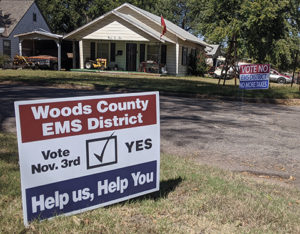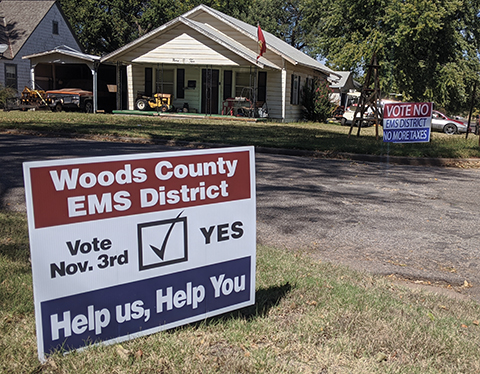by Sean Doherty, Student Reporter

Woods County voters will decide on Nov. 3 whether to supplement funds to all emergency medical service stations in the county.
A proposal to establish a 522 EMS district in Woods County is on the ballot this year. Since 1976, 522 EMS districts in Oklahoma can be formed from a school district, incorporated city or town or county.
These districts, named after Oklahoma State Question 522, which allowed for their formation, may then establish an annual recurring ad valorem tax levy of not more than three mills per dollar of assessed valuation of all taxable property in the district for EMS operations.
If the proposal passes, beginning during the 2021 tax year, Woods County property owners would supplement funds to all three EMS stations: Alva, Freedom and Waynoka.
This tax is an addition to the current property taxes in the county, and will recur every year until a proposition to repeal it appears on a future ballot.
Why should any NWOSU students care? Students or faculty that don’t pay taxes in Woods County aren’t affected. But for those who live here or plan to stay after graduation, this vote is important.
Julie Dennis, director of Alva EMS, is a member of a task force that came together to get this proposal on the ballot. She and the other members of the task force say this tax will provide a constant funding stream that will provide financial flexibility to all three EMS stations, while simultaneously creating a funding mechanism for capital improvements and updates.
The proposal would also offer improved control and better coordination and cooperation.
“It will ensure more effective coverage for our service,” Dennis said. “With the current trend of the state regulations increasing the needs and requirements to be met to maintain current license … this would produce and provide a mechanism in which we could potentially purchase that equipment that we need.”
Each EMS district in the county is different. Alva EMS is a full-time, paid ambulance service funded by a percentage of the city sales tax and EMS charges after ambulance runs. They average 1000 runs each year.
Waynoka EMS is a paid volunteer service, which means their EMTs get paid a small amount for covering shifts funded by city sales tax, EMS charges, and a mandatory subscription on Waynoka residents’ utility bills. Waynoka EMS had approximately 200 runs last year.
Freedom EMS is a volunteer service. Paramedics don’t get paid, patients are not charged for EMS runs and any funding the EMS service receives is from donations or fundraising. They had about 50 runs last year.
If the proposal passes, the tax would generate approximately $645,000 annually. The Woods County commissioners would nominate three individuals from each EMS station to serve on a board to oversee allocation of these funds to each EMS district.
“It’ll have to be a joint venture between the cities and this board,” said Randy McMurphy, chair of the Woods County Commissioners. McMurphy said the board will not have any administrative power over the EMS stations.
“I’m not this board,” he said. “It’s just an oversight to see that the funds are spent right where they need to be spent.”
Dennis reiterated that each EMS station would still be operated independently.
“How (the proposal) is written, it would form an EMS district, not a county-wide EMS service,” Dennis said. “That district is a special taxation district that will contract with the existing agencies that are providing coverage in that area.”
However, the board would provide an opportunity for all three stations to help each other.
“It will allow us to see exactly where there might be a shortfall in another service,” Dennis said. “If there’s a shortfall there, it might allow for us the opportunity to step up and help them in that area, or vice-versa. Having people come together on the board can never hurt because we’re coming together to discuss the mutual issues. And I mean, the only thing that can come from that is increased coordination and cooperation.”
The constant funding stream the 522 district tax levy would provide gives the three EMS stations some breathing room financially.
“It gives us more flexibility,” Dennis said. “We have the ability to put more money into equipment and more money into a person. We have the ability to put more money into training, those types of things. It allows the coordination and cooperation that we already have among three services to function better and more efficiently because we’re not struggling financially.”
Supporters of the 522 proposal say the constant revenue from the mill levy will help stabilize unpredictable sales tax funds.
“We may have $300,000 in sales tax one month, but we may only have $150,000 the next month,” Dennis said. “It’s not a constant, steady stream. What this tax is going to do is to help us plan for the future. We will have a good estimate from now going forward.”
“It’s a really small amount to pay for a service,” McMurphy said.
COST TO TAXPAYERS
According to Woods County Assessor Renetta Benson, there is a simple equation to calculate the additional taxes a property owner will pay. The current assessed value of the property, multiplied by .003 ($3.00 of every $1,000 of assessed property value is taxed) equals the yearly increase in taxes for the property owner.
The assessed value of real estate property like land and structures attached to that land is calculated by multiplying the market value of the property by the assessment rate of 11.5% (.115). Personal property is assessed at a rate of 12% (.12).
For example, if the assessed value of a real estate property is $50,000, the additional tax the property owner would pay is $17.25. If the assessed value of their personal property is also $50,000, the additional tax would be $18.00, for a grand total of $35.25.
The position of the opposition to the 522 EMS district tax is simple: No more taxes. But McMurphy counters.
“I don’t like more taxes either, but I do like to know when I am paying taxes where it’s going,” McMurphy said. “The best way I can put it…who would want to send their kids to college at Northwestern if there wasn’t an ambulance service available?”

